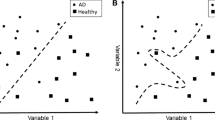Abstract
We describe a method for classifying subjects based on functional magnetic-resonance (fMR) data, using a method combining a Bayesian-network classifier with inverse-tree structure (BNCIT), and ensemble learning. The central challenge is to generate a classifier from a small sample of high-dimensional data. The principal strengths of our method include the nonparametric multivariate Bayesian-network representation, and joint performance of feature selection and classification. Preliminary results indicate that this method can detect regions characterizing group differences, and can, on the basis of activation levels in these regions, accurately classify new subjects.






Similar content being viewed by others
References
Binder, J., Koller, D., Russel, S., & Kanazawa, K. (1997). Adaptive probabilistic networks with hidden variables. Machine Learning, 29, 213–244.
Breiman, L. (1996). Bagging predictors. Machine Learning, 24(2), 123–140.
Breiman, L. (2001). Random forests. Machine Learning, 45(1), 532.
Buckner, R. L., Snyder, A. Z., Sanders, A. L., Raichle, M. E., & Morris, J. C. (2000). Functional brain imaging of young, nondemented, and demented older adults. Journal of Cognitive Neuroscience Supplement, 12(2), 24–34.
Casey, B. J., Cohen, J. D., OCraven, K., Davidson, R. J., Irwin, W., Nelson, C. A., et al. (1998). Reproducibility of fMRI results across four institutions using a spatial working memory task. NeuroImage, 8(3), 249–261.
Chen, R., & Herskovits, E. H. (2005a). A Bayesian network classifier with inverse tree structure for voxelwise magnetic resonance image analysis. In Proceeding of the Eleventh ACM SIGKDD International Conference on Knowledge Discovery in Data Mining (pp. 4–12). New York, NY, USA.
Chen, R., & Herskovits, E. H. (2005b). Graphical-model based morphometric analysis. IEEE Transaction on Medical Imaging, 24(10), 1237–1248.
Chen, R., & Herskovits, E. H. (2007). Graphical-model-based multivariate analysis of functional magnetic resonance data. NeuroImage, 35, 635–647.
Cheng, J., & Greiner, R. (1999). Comparing Bayesian network classifiers. In Proceedings of UAI-99 (pp. 101–108).
Cooper, G.F., & Herskovits, E. H. (1992). A Bayesian method for the induction of probabilistic networks from data. Machine Learning, 9, 309–347.
Esposito, M. D., Zarahn, E., Aguirre, G. K., & Rypma, B. (1999). The effect of normal aging on the coupling of neural activity to the bold hemodynamic response. NeuroImage, 10(1), 614.
Evans, A. C., Collins, D. L., Mills, S. R., Brown, E. D., Kelly, R. L., & Peters, T. M. (1993). 3D statistical neuroanatomical models from 305 MRI volumes. In IEEE-Nuclear Science Symposium and Medical Imaging Conference (pp. 1813–1817).
Ford, J., Farid, H., Makedon, F., Flashman, L. A., McAllister, T. W., Megalooikonomou, V., et al. (2003). Patient classification from fMRI brain activation maps. In Sixth International Conference on MICCAI.
Freund, Y., & Schapire, R. E. (1996). Experiments with a new boosting algorithm. In International Conference on Machine Learning (pp. 148–156).
Friedman, N., Geiger, D., & Goldszmidt, M. (1997). Bayesian network classifiers. Machine Learning, 29, 131–163.
Friston, K. J. (2004). Functional and effective connectivity in neuroimaging: A synthesis. Human Brain Mapping, 2, 56–78.
Friston, K. J., Harrison, L., & Penny, W. (2003). Dynamic causal modeling. Neuroimage, 1273–1302.
Heckerman, D., Geiger, D., & Chickering, D. M. (1995). Learning Bayesian networks: The combination of knowledge and statistical data. Machine Learning, 20, 197–243.
Herskovits, E. H. (1991). Computer-based probabilistic-network construction. PhD thesis, Stanford University.
Kohavi, R., & John, G. H. (1997). Wrappers for feature subset selection. Artificial Intelligence, 97(1–2), 273–324.
Kohler, S., McIntosh, A. R., Moscovitch, M., & Winocur, G. (1998). Functional interactions between the medial temporal lobes and posterior neocortex related to episodic memory retrieval. Cerebral Cortex, 8, 451–461.
Koller, D., & Sahami, M. (1996). Towards optimal feature selection. In Proceedings of the 13th International Conference on Machine Learning (pp. 284–292).
McIntosh, A. R., Grady, C. L., Ungerleider, L. G., Haxby, J. V., Rapoport, S. I., & Horwitz, B. (1994). Network analysis of cortical visual pathways mapped with PET. Journal of Neuroscience, 14(2), 655–666.
Morris, J. C. (1993). The Clinical Dementia Rating (CDR): Current version and scoring rules. Neurology, 43(11), 2412–2414.
Pearl, J. (1988). Probabilistic reasoning in intelligent systems. Morgan Kaufmann.
Statistical Parametric Mapping. (2005). http://www.fil.ion.ucl.ac.uk/spm/.
Tegeler, C., Strother, S. C., Anderson, J. R., & Kim, S. G. (1999). Reproducibility of BOLD-based functional MRI obtained at 4T. Human Brain Mapping, 7(4), 267–283.
Thiesson, B. (1995). Accelerated quantification of Bayesian networks with incomplete data. In Proceedings of the First International Conference on Knowledge Discovery and Data Mining (pp. 306–311). AAAI Press.
Zhang, L., Samaras, D., Tomasi, D., Volkow, N., & Goldstein, R. (2005). Machine learning for clinical diagnosis from functional magnetic resonance imaging. In IEEE Proceedings of CVPR (pp. 1211–1217).
Acknowledgements
This work was supported by The Human Brain Project, National Institutes of Health grant R01 AG13743, which is funded by the National Institute of Aging, the National Institute of Mental Health, and the National Cancer Institute.
Author information
Authors and Affiliations
Corresponding author
Rights and permissions
About this article
Cite this article
Chen, R., Herskovits, E.H. Clinical Diagnosis Based on Bayesian Classification of Functional Magnetic-Resonance Data. Neuroinform 5, 178–188 (2007). https://doi.org/10.1007/s12021-007-0007-2
Published:
Issue Date:
DOI: https://doi.org/10.1007/s12021-007-0007-2




